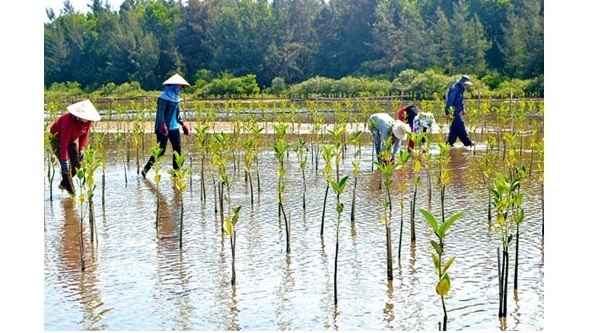MANILA, Philippines — In the face of existential threats from climate change and environmental degradation, the majority of banks in Southeast Asia continue to finance new coal-fired power plants.
This was the finding of the World Wide Fund for Nature (WWF), which 2019 Sustainable Banking Assessment (SUSBA) showed 91 percent of the banks in the region were still “fueling the fire” when it should already be heavily supporting programs for resilient and sustainable economies.
The WWF study assessed 35 banks in six countries of the Association of Southeast Asian Nations (ASEAN) on indicators across six broad pillars of sustainable finance.
“Unfortunately, the ASEAN economy remains highly dependent on fossil fuels, which contributes significantly to greenhouse gas emission,” WWF said in a statement on Wednesday.
“Coal is not the only problem. Rampant deforestation exacerbates climate change and causes biodiversity loss, which threatens food security by disrupting essential ecosystem services such as soil fertility maintenance and pollination,” it added.
The conservation group noted that ASEAN “are also leaving money on the table” by not “actively supporting” initiatives “urgently needed to transition to low carbon and sustainable economy.”
Citing a study by the United Nations Environment Programme Finance Initiative (UNEPFI) and DBS Bank, WWF said the estimated demand for green investment is pegged at $3 trillion from 2016 to 2030 in sectors such as infrastructure, renewable energy, energy efficiency, food, agriculture, and land use.
But while 51 percent of banks that offer green financial products have mostly focused on renewable energy, the study said there “remains a huge financing gap in the other sectors.”
WWF lamented that banks across Southeast Asia “are not responding fast enough” to help address threats of climate change and environmental degradation that may lead to financial instability and social unrest in the region.
“The prosperity of ASEAN’s economies is underpinned by the bedrock of natural capital which provides climate and air quality regulation as well as food and fresh water production,” said Jeanne Stampe, WWF’s Head of Asia Sustainable Finance.
“These are the basic necessities for our societies to thrive. ASEAN’s economies are very much interdependent, which magnifies the effects of climate change and environmental destruction. To ensure that the people of ASEAN have a secure future, ASEAN banks must be the lifeblood of sustainable development,” she also pointed out.
The same WWF study found that only nine percent of the banks it assessed have “no-deforestation” policies. This even if floods have destroyed crops and manufacturing facilities in Thailand, water resources in Malaysia have been projected to reduce by 20 to 25 percent from 2025 to 2030, and major coastal cities like Jakarta in Indonesia were becoming susceptible to sea-level rise, WWF stressed.
WWF said Southeast Asia is “suffering from manifestations of climate change in the form of water-related disasters.”
“ASEAN banks remain highly exposed, with just 17 [percent] of banks recognizing water risks, while none require clients to conduct water risk assessments,” it said.
Bank regulators, however, understand climate change’s threat to financial stability and are responding, according to WWF, that: “By the end of the year, seven banking associations or regulators in ASEAN will have issued sustainable banking guidelines.”
WWF said central banks of Malaysia, Singapore, and Thailand have joined the Network for Greening the Financial System (NGFS), which was established to enhance the ability of the financial system to manage climate risks and mobilize capital for sustainable development.
NGFS has recommended to central banks and supervisors to better integrate climate-related risks into their financial stability monitoring.
“Banks will increasingly be expected to test the resilience of their loan books to climate risks and report the results to their regulators,” WWF said.
WWF also said 374 financial institutions have already endorsed the Task Force on Climate-related Financial Disclosures (TCFD), which has specific recommendations for financial institutions on their climate disclosures.
Not much progress
Still, WWF said, banks across Southeast Asia “have not made much progress to meet these expectations.”
According to WWF, only three banks are developing a strategy to manage climate-related risks or conducting a climate-risk assessment.
Further, the WWF found that only four banks of the 35 banks it assessed fulfilled at least half of the indicators on sustainable finance while 51 percent of the banks fulfilled less than a quarter of the indicators.
“However, there is still progress with 74 [percent] of the banks making some improvement compared to last year. In particular, the three Singapore banks have demonstrated leadership by prohibiting the financing of new coal-fired power plants and implementing no-deforestation commitments,” WWF said.
But the organization said the lack of even and timely progress between banks across Southeast Asia may undermine the region’s sustainable development.
“The uneven playing field undermines the region’s response to these impending threats as unsustainable activities continue to be financed,” the organization said.
WWF said banks must work together on a pre-competitive basis to enable the creation of a “resilient financial sector” which can support the region’s “sustainable development needs and boost livelihoods.”
“The number of heatwaves hitting Europe and Asia-Pacific in recent months is a testament that climate change is already disrupting our daily lives and business operations,” WWF said. /kga










